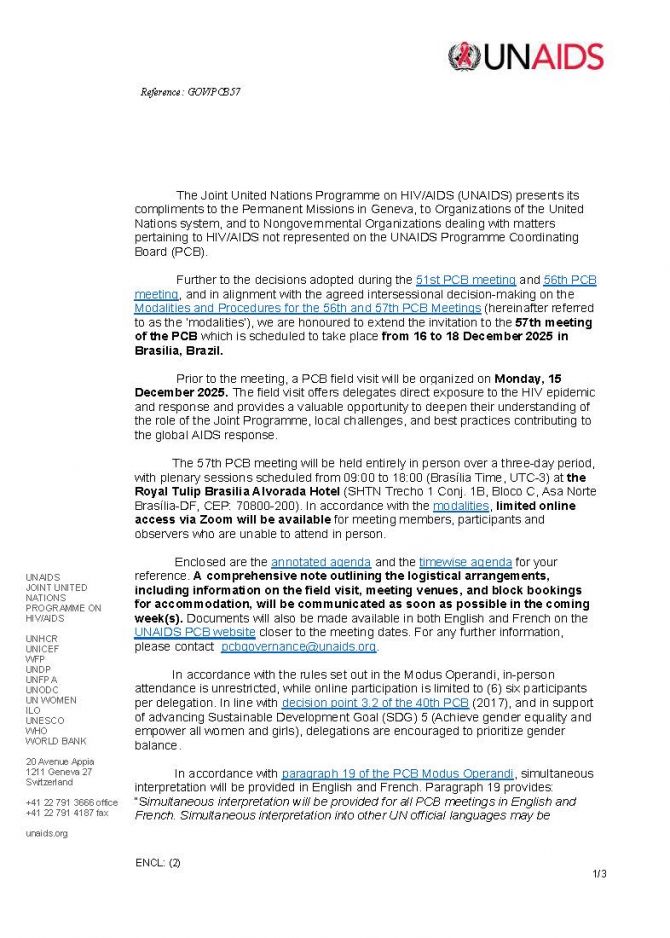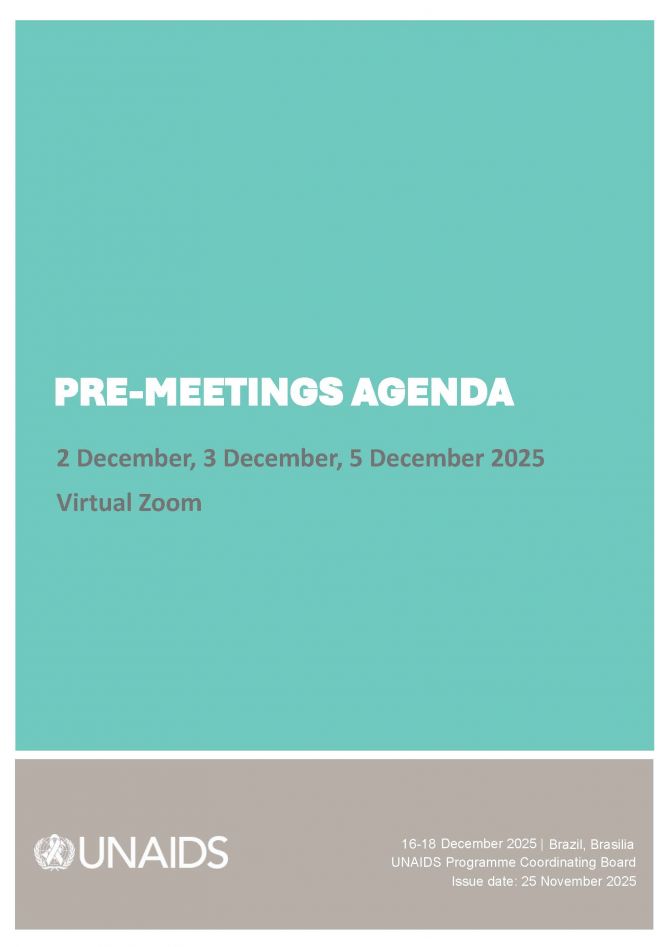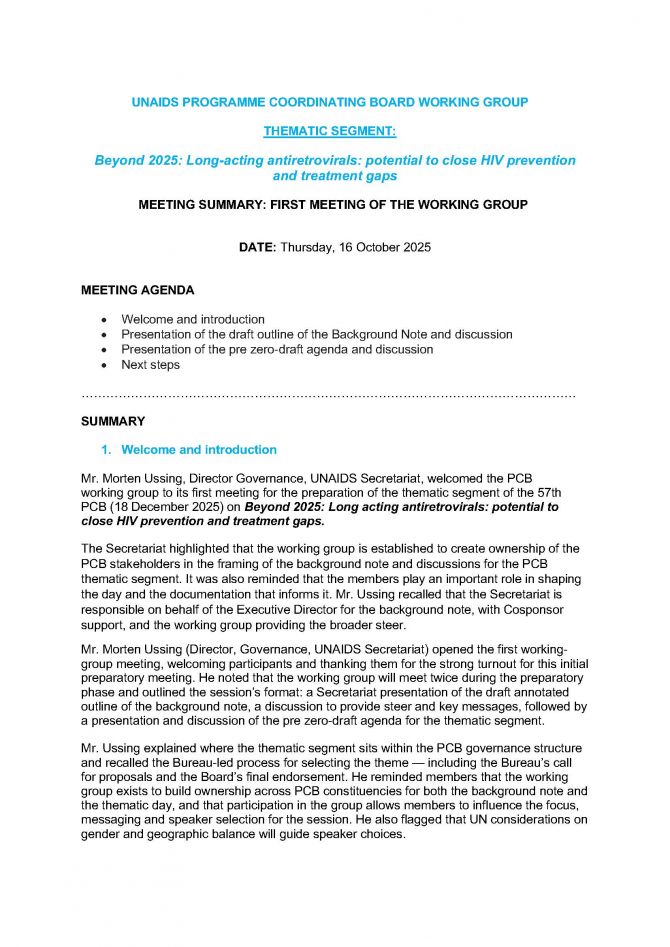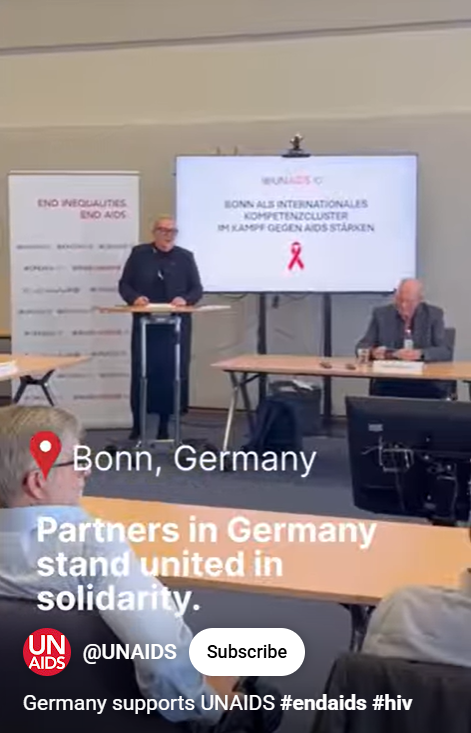
Media Advisory
Upcoming launch of new report by Global Council on Inequality, AIDS and Pandemics, showing how inequalities drive current and future pandemics and what leaders need to do to address them
27 October 2025 27 October 2025A new report by the Global Council on Inequality, AIDS and Pandemics, will be launched on 3 November in Johannesburg - and worldwide online - showing the danger of inequalities that are prolonging current pandemics, such HIV and tuberculosis, and making the world more vulnerable to future pandemics. Read press release
The Council is co-chaired by Nobel prize-winning economist Joe Stiglitz, former First Lady of Namibia Monica Geingos, and Director of the Institute of Health Equity Sir Michael Marmot. It has brought together economists, public health experts and current and former government leaders from around the world.
The launch on 3 November will come ahead of the G20 meetings in South Africa, including the G20 health ministers’ meeting on 6-7 November. The report will also be presented to President Ramaphosa. This year’s G20, chaired by South Africa, has focused its attention on the challenge of inequality.
The report, Breaking the inequality-pandemic cycle – building true health security in a global age, will set out what world leaders need to do to better prepare for future pandemics by reducing inequalities, including addressing the global debt crisis, enabling local research, development and production of new medicines, expanding social protection and supporting communities.
The global event, moderated by Nozipho Mbanjwa-Tshabalala, will be live-streamed by the Mail&Guardian around the world, and will include speakers joining from London, Rio, Madrid, Windhoek, and Kampala, and a studio audience in Johannesburg. It will be immediately followed by a press conference.
WHAT: Launch of the Global Council on Inequality, AIDS and Pandemics report, Breaking the inequality-pandemic cycle – building true health security in a global age. Launch event with interviews of co-chairs and experts from across the world, followed by a press conference and reception.
WHEN: Monday, 3 November 2025, 15:00 South Africa Standard Time
WHERE: Johannesburg, South Africa - and worldwide online
SPEAKERS INCLUDE:
- Winnie Byanyima, Executive Director of UNAIDS and Under-Secretary-General of the United Nations
- Michael Marmot, Institute of Health Equity at University College London
- Joseph Stiglitz, Nobel prize-winning economist
- Monica Geingos, Executive Chairperson, One Economy Foundation and former First Lady of Namibia
- Aaron Motsoaledi, Minister of Health, South Africa
- Nísia Trindade, Former Minister of Health, Brazil
- Javier Padilla Bernáldez, Secretary of State for Health, Spain
- Joe Phaahla, Deputy Minister of Health, South Africa
- Richard Lusimbo, Director General of the Key Populations Consortium, Uganda
- Nomonde Ngema, HIV youth activist, South Africa
For media attendance at the launch event and press conference in person or online, and for interviews and access to the embargoed report, please contact:
Robert Shivambu in Johannesburg | tel. +27 83 608 1498 | shivambuh@unaids.org
or Oliver Aplin in London | tel. +44 785 155 2441 | oca10@georgetown.edu
About the Global Council on Inequality, AIDS and Pandemics
The Global Council on Inequality, AIDS and Pandemics is a high-level initiative convened by UNAIDS to confront how inequalities drive pandemics—and how pandemics, in turn, deepen inequality. Announced in June 2023, the Council is co-chaired by Namibia’s former First Lady Monica Geingos, Director of the UCL Institute of Health Equity Professor Sir Michael Marmot, and Nobel laureate Joseph E. Stiglitz. It brings together leaders across economics, public health, human rights and finance to build a policy environment in which inequalities can be addressed so the world can end AIDS and better prepare for and respond to future pandemics.
Breaking the inequality-pandemic cycle: Building true health security — Findings and recommendations of the Global Council

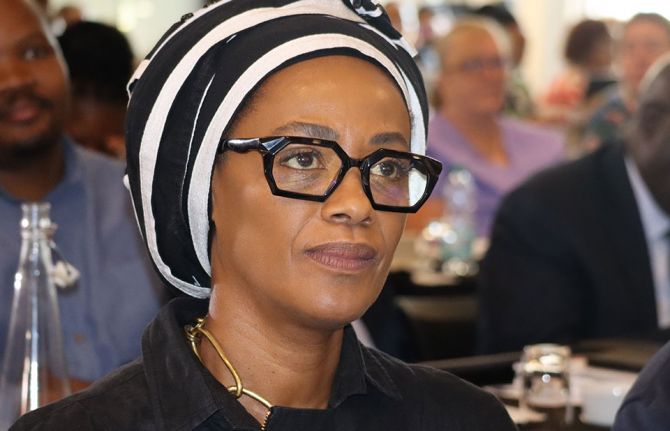

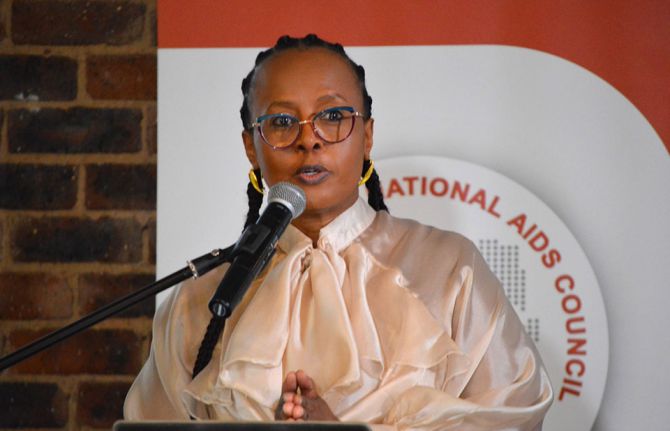
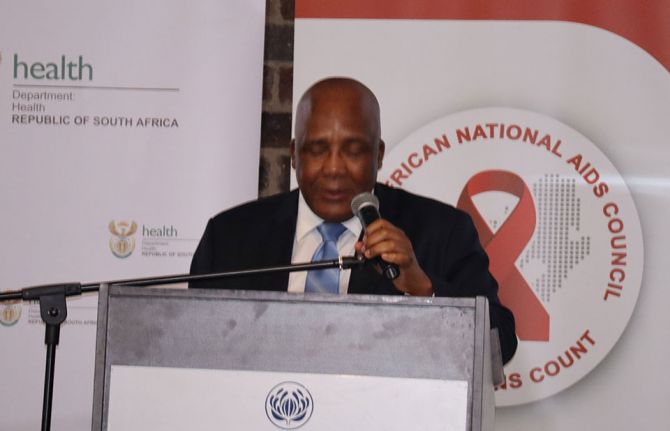
Feature Story
South Africa charts a new frontier by rolling out a twice-yearly injection which is almost 100% effective in preventing HIV
24 October 2025
24 October 2025 24 October 2025South Africa has taken a decisive step towards stopping new HIV infections. The South African National AIDS Council (SANAC) and the National Department of Health, in collaboration with UNAIDS, convened a two-day national meeting on access to a new, and potentially groundbreaking medicine (lenacapavir) which is set to be rolled out in South Africa in early 2026.
Minister of Health Dr Aaron Motsoaledi affirmed government’s commitment to make lenacapavir “a public good - accessible, affordable and locally produced”. He emphasised the importance of prioritising adolescent girls and young women. There are around 8 million people living with HIV in South Africa and every week around 1000 adolescent girls and young women become newly infected with HIV.
“The introduction of lenacapavir marks the beginning of a new phase in HIV prevention, one grounded in collaboration between government, communities, our partners like the Global Fund and UNAIDS and the private sector,” said Dr Motsoaledi. “This partnership must be accountable, transparent and inclusive if we are to achieve our national targets.”
South Africa is among nine countries globally selected to roll out the medicine under the Global Fund to Fight AIDS, TB and Malaria’s financial commitment to reach 2 million people across low- and middle-income countries.
“Science continues to offer us new tools, but innovation alone is not enough,” said Eva Kiwango, UNAIDS Country Director for South Africa. “Equity must follow. Communities, especially young women and key populations, have waited too long for HIV prevention they can trust and use with dignity.”
Through a US$ 29 million grant, South Africa will receive enough medicine to provide HIV prevention to 450 000 people at high risk of HIV during a rollout in 23 high-incidence districts across six provinces. The aim is to reach adolescent girls, young women, sex workers, men who have sex with men, people who use drugs and other at risk populations.
“We are not gathered merely to discuss a medicine, but to reaffirm our collective commitment to justice and equality,” said Steve Letsike, Deputy Minister for Women, Youth and People living with Disabilities. “No young woman, no queer person, no person with a disability must be left behind in the promise of HIV prevention.”
Across both days, a common message resonated: partnership is South Africa’s greatest strength. Dr Thembisile Xulu, SANAC CEO, called for unity of purpose noting, “We must move from conversation to coordination, and from coordination to action.”
Yvette Raphael, Co-founder of the Advocacy for Prevention of HIV and AIDS in South Africa emphasised the need to take the message to communities, saying, “Civil society must be given the tools for demand creation to provide research literacy in the way that we and communities understand.”
The evidence and the promise
Presenting findings from the PURPOSE 1 and 2 trials, Professor Linda-Gail Bekker, CEO of the Desmond Tutu Health Foundation reported 100 % efficacy among cisgender women and 96% efficacy among men, transgender and non-binary participants. She highlighted that long-acting prevention tools such as lenacapavir expand choice, strengthen agency, and promote equity, offering new hope to those who need discreet and durable protection.
Professor Helen Rees, from WITS RHI, emphasised the issue of misinformation and disinformation as South Africa prepares to roll out lenacapavir next year. She said that all stakeholders, “Must underscore the importance of science because if there is mistrust in science, people will not trust new products. As we roll out lenacapavir we must have our ears on the ground for misinformation and disinformation.”
Gilead Sciences, developer of lenacapavir, represented by Country Manager, Wendy Cupido affirmed its commitment to ongoing dialogue and partnership with the Government of South Africa and stakeholders to ensure affordable, equitable access. She noted that the manufacturer of lenacapavir Gilead remains ready to engage with the country and partners as they explore local manufacturing readiness.
Speaking during a panel discussion, young Shout Out Now ambassador, Lerato explained the impact of missing one day of oral PrEP means putting yourself at risk of acquiring HIV. She said, “I am looking forward to lenacapavir to reduce my monthly visits to the clinic to access medication and all the relevant screenings to keep myself safe from HIV. It will make my life easier.”
Dr Yogan Pillay, Director HIV and TB delivery at the Gates Foundation underlined how collaboration is transforming affordability. Recent landmark agreements secured by Unitaid, CHAI, Wits RHI and Gates will make generic lenacapavir available at a cost of US$ 40 a year in 120 low- and middle-income countries starting in 2027. “Sustainability isn’t imported -it’s built,” he said, noting the importance of local manufacturing and data-driven delivery.
The meeting entitled Lenacapavir Access and Sustainability was held in Johannesburg on 14 and 15 October, 2025. Over 100 participants participated in person and 130 joined virtually. The consultation marked the launch of the rollout of Lenacapavir in South Africa which is set to start in 2026.
Region/country
Related
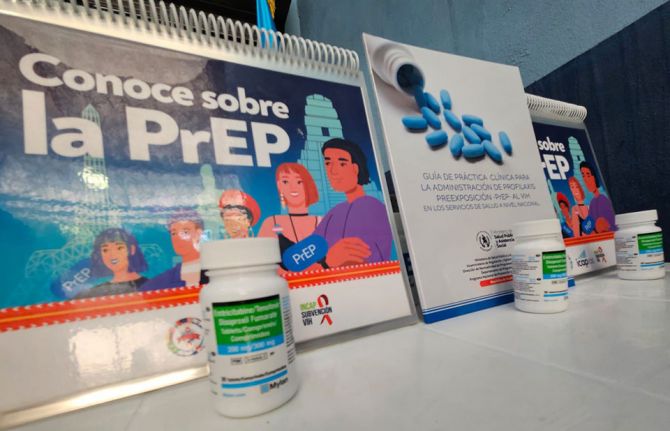 Multisectoral resilience to funding cuts in Guatemala
Multisectoral resilience to funding cuts in Guatemala

22 December 2025
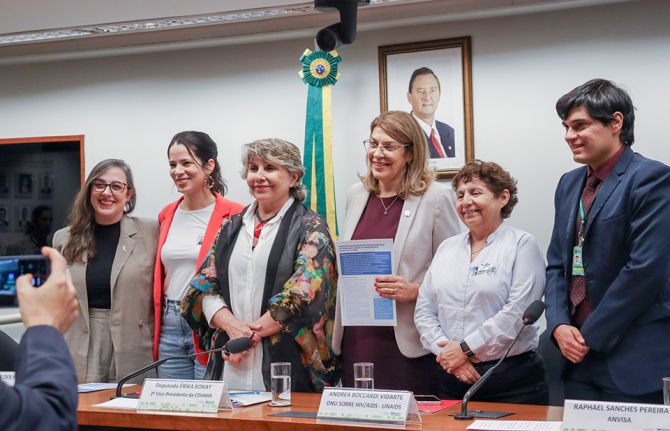 Lower prices needed for new HIV prevention medicine in Brazil
Lower prices needed for new HIV prevention medicine in Brazil

09 September 2025

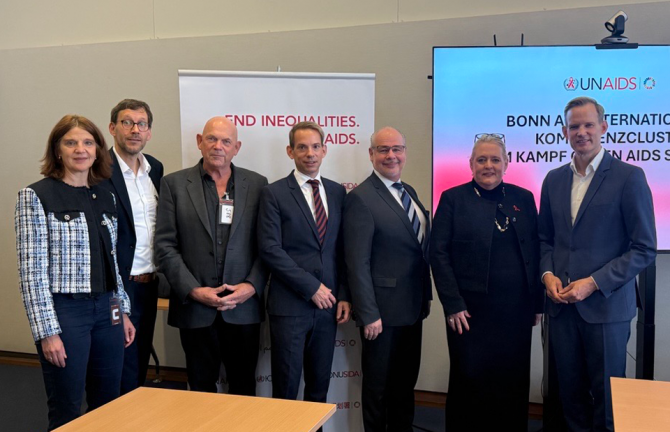
Feature Story
Germany steps up support to UNAIDS amidst HIV funding crisis
23 October 2025
23 October 2025 23 October 2025As global HIV funding faces mounting pressure, Germany is stepping up its support to ensure the world remains on track to end AIDS by 2030. As donors reduce contributions, UNAIDS and its partners are facing growing challenges in maintaining access to life-saving HIV prevention and treatment services worldwide. Germany’s leadership comes at a crucial time.
At the World Health Summit last week in Berlin, Germany announced an additional €2.5 million in core funding to UNAIDS, bringing its total core contribution for 2025 to €5.5 million. Germany also announced a €1 billion commitment to the Global Fund to Fight AIDS, TB and Malaria’s Eighth Replenishment.
Germany has long been one of UNAIDS’ most steadfast and trusted partners. With the support of the Federal Foreign Office, UNAIDS has established a major hub in Bonn as part of a broader transformation to make the organization more effective, efficient, and fit for purpose. The Federal Foreign Office has pledged an additional €500,000 to support the relocation of additional staff from Geneva to Bonn, as well as a €1.2 million contribution to strengthen UNAIDS’ work with LGBTIQ+ communities worldwide.
At an event held at the United Nations Campus in Bonn this week, around 30 representatives from the German Federal Government, academia, civil society, AIDS activists, and international development and global health organizations came together to explore how to further strengthen the partnership between UNAIDS and Germany and to reinforce Bonn’s role as a key global hub for health and HIV.
“Crisis often creates opportunities for change,” said Christine Stegling, UNAIDS Deputy Executive Director. “As UNAIDS redefines its structure to better serve the global AIDS response, Germany’s partnership is of central importance. It sends a powerful message when, at a time when others are stepping back, Germany steps forward—affirming that ending AIDS remains a political priority.”
The event also featured remarks by Georg Kippels, Parliamentary State Secretary of the Federal Ministry of health, who emphasized Germany’s founding role in establishing UNAIDS in 1996 and reaffirmed the Federal Government’s long-term support. “UNAIDS reaches people who are often left behind—people who use drugs, those facing discrimination and young women. Germany will continue to stand by UNAIDS to ensure that no one is excluded from the global AIDS response,” said Mr Kippels.
A subsequent panel discussion opened with a statement by Hendrik Streeck in his triple role as local Member of Parliament from Bonn, Director of the Institute of Virology at the University Hospital Bonn and Federal Commissioner on Drugs. Panelists Paul Zubeil, Federal Ministry of Health, Peter Wiessner, Action Alliance against AIDS and Anne von Fallois, Chief Executive Officer, German AIDS Foundation highlighted Germany’s leadership in the global response, the vital role of civil society, and new opportunities for collaboration within Bonn’s expanding AIDS competence cluster.
Paul Zubeil left no doubt that UNAIDS is a critical actor as the global context of the AIDS response is radically shifting: “The Federal Ministry of Health is working closely with UNAIDS and has seen it manouevering the new realities in a proficient manner. UNAIDS can support domestic stakeholders in high-burden settings to take more ownership while ensuring that key populations remain at the centre o the response. "The fundamental values of UNAIDS’ approach are based on scientific evidence, human rights, and the inclusion of key populations,” said Mr Wiessner. “UNAIDS brings everyone to the same table—governments, civil society, and affected communities—and that’s what makes it unique and invaluable.”
Hendrik Streeck underlined that medical innovation remains key to ending AIDS, citing the example of Lenacapavir, a new injectable drug that can protect a person from HIV infection for an entire year. “The Bonn research ecosystem is ideally placed to contribute to such breakthroughs,” he noted.
Anne von Fallois emphasized the importance of continued collaboration between international organizations and civil society actors based in Bonn. “UNAIDS plays an essential role in connecting us. In Bonn and across Germany, we must continue working together to ensure that HIV remains a priority on the global health agenda. UNAIDS provides us with information, guidance, and context for our work—and reminds all of us that the fight against HIV is not over yet.”
This year, UNAIDS is expanding its staff presence in Bonn to strengthen collaboration with the city’s leading global health research institutions and UN organizations. Once the current restructuring is complete, Bonn will become UNAIDS’ largest hub, underscoring its growing importance as a centre for innovation, research, and partnership in the global AIDS response.



